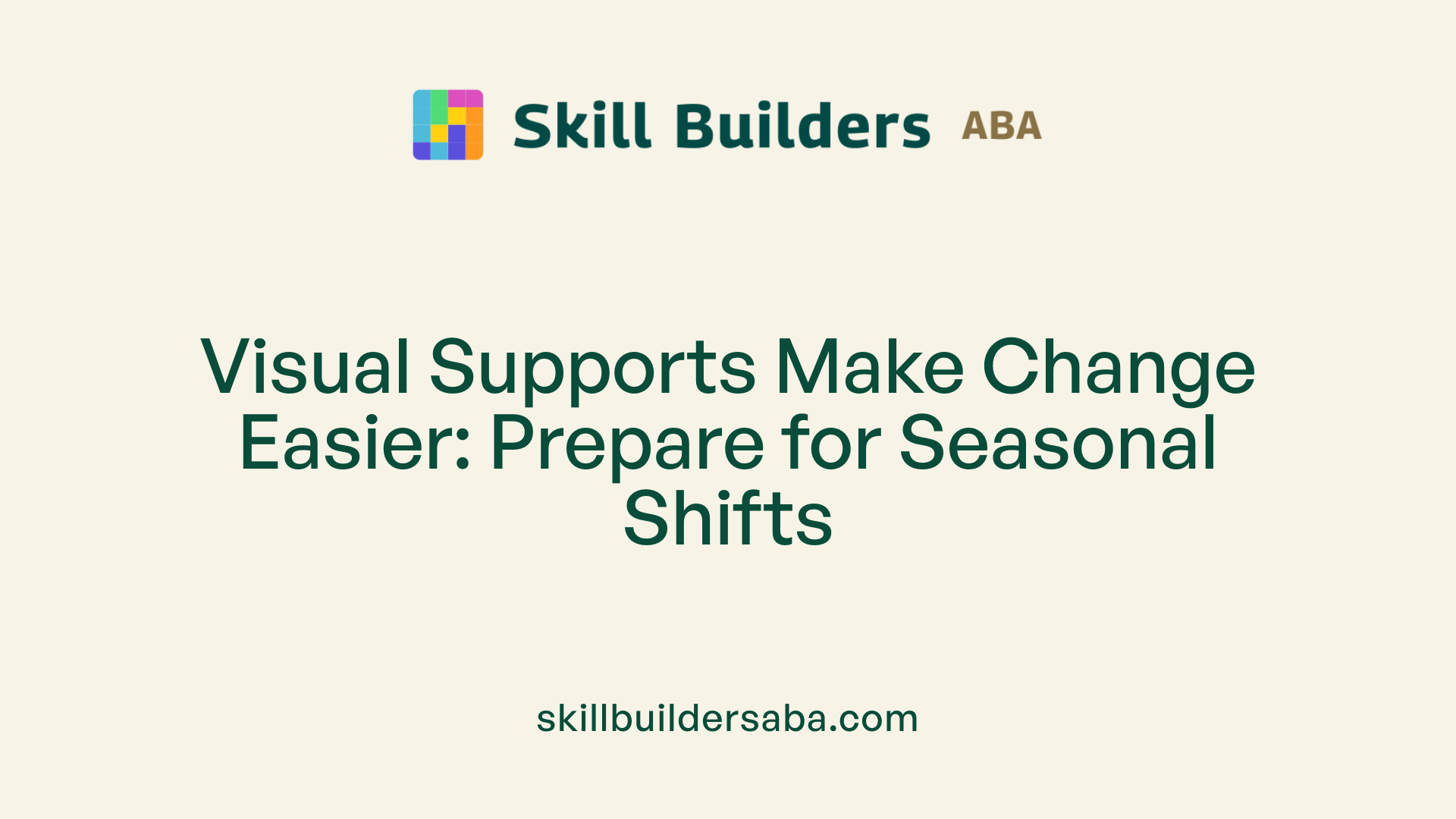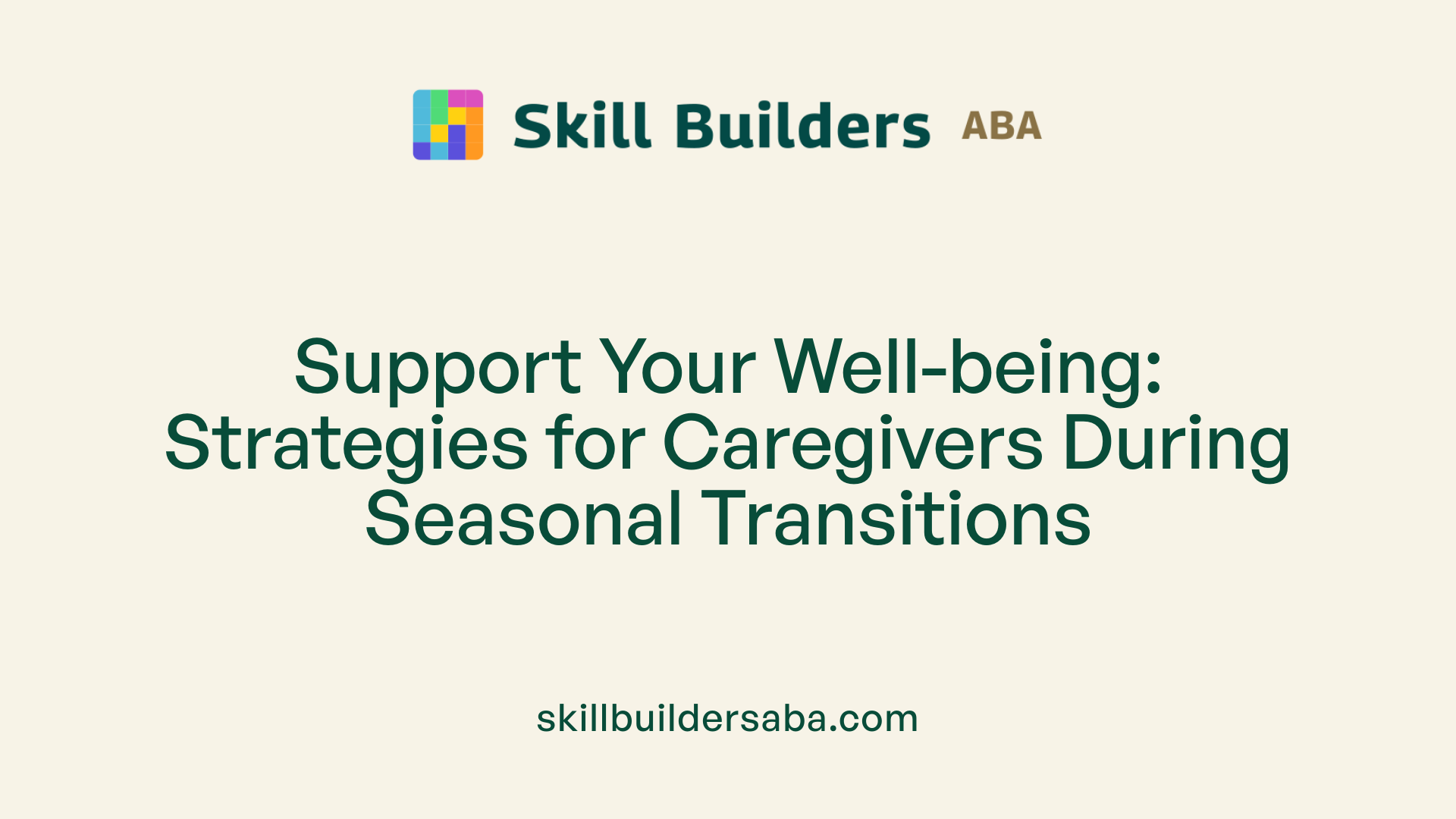
ABA tips for holiday and seasonal transitions
Navigating the Holidays with Confidence: ABA Strategies for Seasonal Transitions
Preparing for a Smooth Transition During Holidays and Seasonal Changes
The holiday season and changing seasons can introduce a variety of challenges for children with autism, including sensory overload, disrupted routines, and social anxiety. Implementing effective ABA techniques and practical strategies can significantly ease these transitions, promoting a sense of stability, security, and joy for children and their families. This article explores comprehensive tips grounded in evidence-based practices to help children with autism navigate holiday and seasonal shifts confidently and comfortably.
Creating Visual Supports and Predictability

What are some practical tips for managing routines and minimizing stress during holidays and seasonal shifts?
To help children with autism navigate the busy holiday season, it is essential to maintain as much consistency as possible. Creating visual schedules and calendars ahead of time can provide a clear view of upcoming events, reducing uncertainty. Incorporating visual aids such as timers and countdowns helps children anticipate changes and transitions.
Gradual adjustments to routines, including pre-teaching new activities and environments, can ease the transition. Establishing predictable patterns and providing a familiar structure during holiday activities helps children feel safer and reduces anxiety.
How can techniques help children with autism adjust to seasonal changes?
Techniques like social stories, visual supports, and scheduled routines are invaluable during seasonal transitions. Social stories prepare children for upcoming changes by explaining what to expect in simple, clear language, reducing fear and confusion.
Using visual schedules and aids allows children to understand new routines and anticipate shifts in daily activities. Gradually exposing children to seasonal stimuli, such as lights and sounds, helps desensitize sensitivities and promotes a smoother adaptation.
What approaches can be used to re-establish routines after holiday breaks?
Returning to routines after holiday breaks may pose challenges for children with autism. A slow, phased approach is most effective.
Start by reintroducing familiar routines gradually, using visual supports like schedule cards and transition cues. Reinforcing routine activities through consistent prompts and positive reinforcement encourages comfort and familiarity.
Engaging children in routine activities early after the break helps re-establish a sense of normalcy and security.
What strategies are effective for ABA therapy during holiday and seasonal transitions?
Continuity is vital during busy holiday periods. Maintaining ABA therapy schedules as much as possible helps ensure ongoing progress.
Pre-teaching activities with visual supports and social stories prepares children for upcoming changes. Using reinforcement strategies and gradually introducing new stimuli can make transitions smoother.
Adjusting therapy sessions to include holiday-related activities, while keeping core routines intact, encourages adaptation and reinforces learned skills.
How can support methods help with sensory overload and social interaction challenges during transitional periods?
Supporting children during seasonal changes involves addressing sensory sensitivities and social challenges.
Visual schedules, timers, and cue cards can prepare children for upcoming events, helping them manage sensory overload by setting clear expectations.
Designating calming spaces or sensory-safe zones offers children a retreat if they become overwhelmed.
Role-playing social interactions and practicing expected behaviors through social stories increase comfort in social gatherings, fostering more positive experiences.
How can ABA techniques be used to ease transitions for children with autism?
ABA strategies facilitate smoother transitions by making changes predictable and manageable.
Visual supports, such as transition cards, help children understand what is happening next, reducing anxiety.
Reinforcement systems encourage desired behaviors during transitions, whereas practice and repetition solidify new routines.
Planning transitions in small, manageable steps, along with continuous positive reinforcement, greatly reduces problematic behaviors and boosts confidence.
| Technique | Application | Benefits |
|---|---|---|
| Visual Schedules | Daily routines, holiday plans | Reduces confusion, enhances predictability |
| Social Stories | Preparing for social events | Reduces fear, increases understanding |
| Visual Timers & Countdowns | Transition periods | Manages expectations, decreases anxiety |
| Safe Spaces | Sensory overload relief | Promotes self-regulation |
| Reinforcement & Practice | Habit formation | Encourages positive behaviors |
Creating a structured, predictable environment supports children with autism during times of change. By integrating visual supports, familiar routines, and sensory accommodations, families and therapists can help children navigate holidays and seasonal shifts with confidence, reducing stress and fostering positive experiences.
Addressing Sensory Sensitivities and Overloads

What support methods help with sensory overload during holiday periods?
Children with autism often experience heightened sensitivities to sensory stimuli, especially during busy holiday seasons. To help manage this, parents and caregivers can provide sensory tools like noise-canceling headphones, weighted blankets, sunglasses, and ear defenders. These tools help children regulate their sensory input and feel more comfortable.
Creating designated sensory-safe zones is another effective method. These are calm, quiet spaces where children can retreat if they feel overwhelmed. Incorporating these areas into holiday environments provides children with a physical and emotional refuge, essential for maintaining calmness.
Gradual exposure to sensory stimuli can also lessen sensitivities over time. Playing sounds at lower volumes before festivities or slowly introducing holiday lighting can help children adjust. This incremental approach reduces the likelihood of sensory overload during big events.
How can sensory accommodations be incorporated into seasonal routines?
Adapting routines with sensory considerations ensures children with autism can better cope with holiday changes. Using visual supports such as visual schedules, countdown calendars, and transition cards can prepare children for upcoming changes. These tools provide predictability and reduce confusion.
Creating sensory-friendly activities along with structured, predictable environments supports children's sensory regulation. For example, incorporating calming music, soft lighting, and familiar textures during activities helps children feel secure.
Maintaining routine elements is critical. Consistent bedtimes, meal times, and quiet periods should be preserved as much as possible. When routine adjustments are necessary, introducing them gradually—using visual aids and cues—can ease transitions.
What practices can help children cope with sensory overload at social gatherings?
Social gatherings, such as family dinners or holiday parties, can be challenging for children with sensory sensitivities. Early identification of signs of overload—like covering ears, withdrawal, or agitation—is vital.
Preparing children by discussing what to expect using social stories and visual supports helps manage their anticipatory anxiety. Role-playing social situations can also increase comfort and familiarity.
During gatherings, bringing familiar items such as a blanket, toy, or sensory tool provides reassurance. Designating a quiet space within the setting where children can take short breaks is equally important. These retreats prevent escalation by giving children control over their sensory environment.
Spotting early signs of sensory overload allows caregivers to intervene promptly. Adjusting lighting, reducing noise levels, or offering a calming activity can help children regain composure.
Implementing these strategies creates a supportive environment that respects each child's sensory needs, fostering enjoyable holiday experiences for everyone involved.
Re-establishing Routines and Supporting Emotional Well-being

What approaches work best for re-establishing routines after holiday breaks?
To help children with autism transition smoothly back to their regular routines after the holiday season, gradual re-introduction of routines is most effective. Start by gradually shifting bedtimes and wake-up times closer to regular schedules, rather than abrupt changes. Visual supports such as visual schedules, timers, and countdowns are invaluable tools for reminding children of the upcoming routine and reducing uncertainty.
Maintaining consistent timing for activities ensures children know what to expect, helping to decrease anxiety and behavioral outbursts. Incorporating engaging activities, like fun games or favorite calm-down routines, can ease the transition. Be patient, and remember that consistent reinforcement and emotional support—offering praise for small progress and patience through setbacks—are vital for success.
How does involving children in holiday preparations benefit them?
Involving the child in holiday preparations can greatly boost their sense of participation and control. For children with autism, participation in activities like decorating, cooking, or setting up holiday decorations fosters confidence and a feeling of agency.
This involvement also helps them understand upcoming events and what to expect, reducing fears of the unknown. Sharing the planning and explaining each step using visual aids and social stories helps children anticipate changes and understand their role in holiday activities. This preparation minimizes anxiety and enhances their overall engagement, making holiday experiences more positive and memorable.
What coping skills can be taught to children to manage stress and change?
Teaching children effective coping skills is essential for managing stress during holiday transitions or sensory overload moments. Deep breathing exercises that children can practice with visual prompts help calm their nervous systems.
Using visual prompts such as cue cards, charts, or apps like Proloquo2Go or Avaz supports communication and self-expression, allowing children to express their needs or feelings clearly.
Modeling calm behavior is also powerful; if caregivers remain composed, children are more likely to mirror those responses. Creating sensory-safe zones, such as a quiet corner or space with calming objects like weighted blankets or noise-canceling headphones, provides children with an immediate tool to self-regulate when overwhelmed.
Incorporating these skills into daily routines not only prepares children for holiday-related changes but also equips them with lifelong strategies for handling various stressful situations.
Enhancing Social Skills and Community Engagement
How can social stories and role-playing improve children's comfort during holiday gatherings?
Social stories and role-playing are effective tools for preparing children with autism for social gatherings. By providing a clear and predictable narrative about what to expect during holiday events, social stories help reduce anxiety and build confidence. Role-playing activities allow children to practice social interactions, such as greeting relatives or participating in group activities, in a safe and controlled environment. This rehearsal helps children understand social cues, appropriate behaviors, and expected responses, thereby decreasing fear and increasing their comfort and engagement during real festivities.
What steps can families take to create inclusive environments?
Families can foster inclusivity during holiday celebrations by educating guests about autism. Sharing information about the child’s needs and sensitivities ensures that everyone understands how to support them. Setting clear expectations about noise levels, physical contact, and sensory sensitivities helps create a respectful environment. Planning sensory-friendly settings, such as quiet zones and sensory tools, allows children to self-regulate when overwhelmed. Additionally, organizing activities that accommodate different abilities and involving children in holiday preparations can promote participation and a sense of belonging.
How can community resources support children with autism in holiday settings?
Community-based events designed for children with autism, such as Santa Cares or sensory-friendly holiday programs, provide safe, inclusive, and enjoyable experiences. These events often reduce sensory overload by controlling lighting, noise, and crowd size. Participating in such programs allows children to enjoy festive activities alongside peers in supportive environments. Community resources also include local support groups, therapists, and organizations offering guidance on holiday planning tailored to children with autism. These resources help families navigate seasonal challenges while fostering community connection and social development.
| Topic | Actions | Details |
|---|---|---|
| Preparing children for social interactions | Use social stories and role-playing | Reduce fear, increase familiarity, and promote participation |
| Creating inclusive holiday experiences | Educate guests, plan sensory-friendly spaces | Foster understanding and comfort for children with autism |
| Community support from resources | Participate in autism-friendly events | Provide enjoyable, supportive environments during holidays |
Advancing social skills and community engagement during the holiday season can significantly improve the experience for children with autism. With thoughtful preparation and community involvement, families can create joyful and inclusive celebrations that support social growth and strengthen bonds.
Supporting Sleep and Routine Consistency

What are best practices for maintaining sleep routines during seasonal changes?
Maintaining consistent sleep routines during holidays and seasonal shifts is essential for children with autism. Gradually adjusting bedtimes allows children to adapt to new schedules without sudden disruptions. For example, shifting bedtime by 15-minute increments over several days helps their body clock adjust smoothly.
Creating calming pre-sleep routines can signal to the child that it's time to wind down. Activities such as gentle reading, calming music, or a warm bath help prepare the mind and body for sleep. Visual supports, like picture schedules or bedtime charts, reinforce these routines and make them more predictable.
Using visual cues to remind children of their sleep routine reduces anxiety and helps establish a stable nightly pattern. This consistency is especially important during seasonal changes when environmental factors, such as light exposure, may interfere with sleep.
How do sleep disruptions affect behavior in children with autism during holidays?
Disruptions in sleep patterns often have a noticeable impact on children with autism during the holiday season. Lack of adequate rest can lead to increased irritability and mood swings, making it harder for children to cope with changes.
Sleep disturbances can also impair focus and concentration, which might cause behavioral issues or heightened stress during holiday activities. These challenges can make social interactions and participation in festivities more difficult for children and their families.
Recognizing and addressing sleep issues early can mitigate these negative behaviors and contribute to a more positive holiday experience.
What strategies help children transition back to regular routines post-holiday?
Re-establishing sleep routines after holidays requires patience and consistency. A gradual re-adjustment works best, such as slowly shifting bedtimes back to pre-holiday times over several days.
Visual supports can be particularly helpful during this period. Using picture charts or timers to indicate when it’s time to wind down creates clear expectations. Maintaining a consistent sleep environment—such as a quiet, dark, and comfortable room—also promotes better rest.
Implementing gentle signals, like a calming voice or a favorite nightlight, reinforces the transition. Celebrating small successes during the re-establishment phase encourages continue adherence to routines.
Additional insights into sleep routines during holidays for children with autism
| Strategy | Description | Supporting Tools |
|---|---|---|
| Gradual Adjustments | Shift sleep times slowly over several days | Timers, visual sleep charts |
| Consistent Bedtime Rituals | Keep pre-sleep activities similar each night | Routine charts, calming objects |
| Visual Supports | Use pictures or symbols to outline routine steps | Visual schedules, countdowns |
| Sensory-Friendly Environment | Create a sleep space tailored to sensory needs | Weighted blankets, blackout curtains |
| Reinforcement and Celebrations | Reward adherence to routines with praise or rewards | Sticker charts, verbal praise |
Creating a supportive sleep environment and using visual supports can greatly improve sleep consistency for children with autism during seasonal changes. These strategies help reduce anxiety, improve mood, and foster better behavior, ensuring that the holiday period remains as enjoyable and stress-free as possible for the whole family.
For more tailored approaches, consulting with an autism-trained sleep specialist can provide additional strategies suited to individual needs. Remember, patience and consistency are paramount when supporting sleep routines during these transitional times.
Empowering Families and Caregivers

What support do parents and caregivers need during seasonal transitions?
During holiday seasons and other seasonal changes, parents and caregivers of children with autism face unique challenges. To navigate these successfully, self-care becomes vital. Managing a child's routine, sensory sensitivities, and social needs can be overwhelming, so caregivers should prioritize their own well-being. Setting clear boundaries helps prevent burnout by establishing manageable limits around holiday activities, visitor interactions, and responsibilities.
Collaboration with professionals, especially ABA therapists, provides customized strategies tailored to a child's specific needs. Support groups also offer emotional relief, practical advice, and a sense of community, reinforcing that they are not alone in their experiences.
How can professional support enhance family strategies?
Engaging with ABA therapists and participating in parent training programs can significantly improve how families handle seasonal transitions. Therapists can guide families on creating visual supports, structured routines, and gradual exposure techniques to help children adapt better.
These professionals can also prepare children for upcoming changes, suggest sensory-friendly tools, and help develop social stories that ease anxiety. Consistent therapy sessions—even during holidays—maintain progress and stability, making transitions smoother.
Why is sharing success stories valuable?
Sharing experiences among families fosters motivation and creates a supportive community. Learning from others’ successes and setbacks provides practical insights that can be adapted to individual circumstances.
Celebrating small achievements encourages continued effort and resilience, boosting confidence among parents and caregivers. Moreover, success stories showcase innovative strategies and foster hope, reinforcing that positive outcomes are attainable when combining professional guidance, planning, and community support.
| Support Strategies | Examples | Benefits |
|---|---|---|
| Self-care and Boundaries | Taking breaks, setting limits on holiday commitments | Prevents burnout, maintains mental health |
| Professional Collaboration | ABA therapy, parent training | Tailored strategies, ongoing support |
| Community Sharing | Success stories, support groups | Motivation, practical insights |
Incorporating these approaches can create a more manageable and fulfilling holiday experience for children with autism and their families.
A Holistic Approach to Seasonal Transitions and Autism Support
By integrating visual supports, sensory accommodations, gradual routines, social preparation, sleep management, and family empowerment, families and educators can provide children with autism a stable and positive experience during holiday and seasonal transitions. Consistent application of ABA principles tailored to each child's needs fosters resilience, reduces anxiety, and enhances overall well-being, making festive seasons more joyful and less stressful for everyone involved.
References
- 7 expert tips for creating a happier holiday for children with autism
- Helping Autistic Children with Seasonal Changes - Move Up ABA
- Autism and the Holiday Season: How to Turn Therapy Challenges ...
- Episode 125: Tips to Reduce Holiday Stress for Learners with Autism
- Easing a Child with Autism Back into Routine After the Holiday Break
- 10 Tips for Helping Children with Autism Through the Holidays
- Autism and the Holidays: 11 Tips for Inclusive Celebrations
- ABA Tips for a Joyful Family Holiday Season
- Preparing your child with ASD for the holidays - ABA Solutions
- Helping Autistic Children with Seasonal Changes - Move Up ABA
Reach Out Today
Learn more about how we can support your child’s growth and development. Contact us to discuss our services and availability in your area.
.svg)